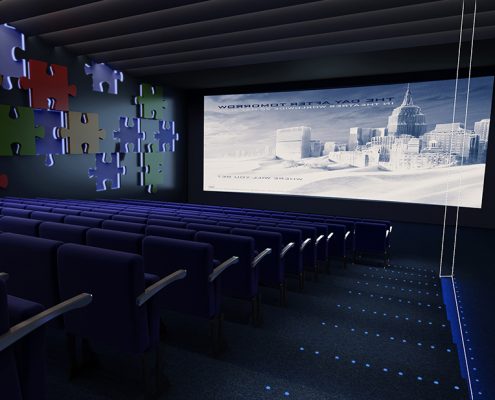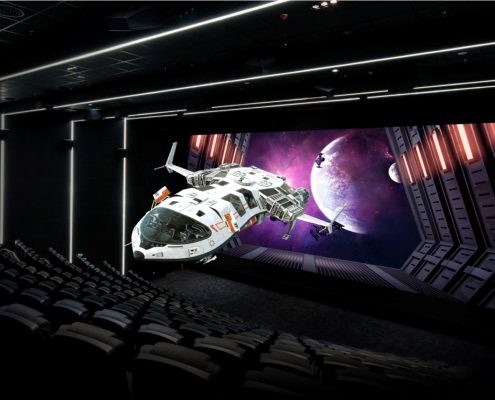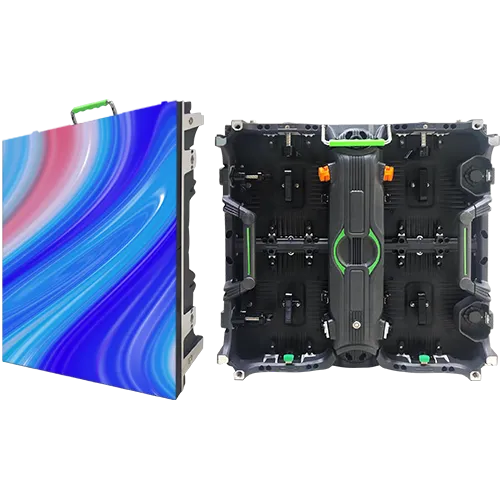Online Consultation or Need a Quote?
The journey of cinema screen technology has been a fascinating evolution, marked by continuous innovation and technological breakthroughs. From the early days of silent films projected on plain surfaces to the introduction of high-definition digital screens, the way we experience movies has transformed dramatically. In this ever-evolving landscape, a new player has emerged, revolutionizing the cinematic experience: cinema LED screens. These screens represent a significant leap from traditional projection methods, offering unparalleled brightness, contrast, and color accuracy. As we delve into the world of cinema LED screens, we explore how they are redefining the standards of visual storytelling, providing audiences with an immersive experience that was once unimaginable. This introduction to cinema LED screens will uncover their unique attributes and how they are setting a new benchmark in the movie-going experience.
Learn Cinema LED Screens
Explanation of What Cinema LED Screens Are
Cinema LED screens are a groundbreaking advancement in display technology, specifically tailored for movie theaters. Unlike traditional projection systems, these screens are made up of numerous tiny LEDs (Light Emitting Diodes) that emit light and color independently. This technology allows for a direct display of the image on the screen without the need for projection. The result is a picture that is exceptionally vivid, with deep blacks and bright whites, offering a more lifelike and immersive viewing experience.
Comparison with Traditional Movie Theater Screens
To understand the significant leap cinema LED screens represent, it’s helpful to compare them with traditional movie theater screens:
| Feature | Traditional Movie Theater Screens | Cinema LED Screens |
|---|---|---|
| Image Quality | Dependent on projector quality and ambient light | Consistently high-quality regardless of external factors |
| Brightness | Limited, can be affected by projector bulb life | Significantly brighter, offering more vivid images |
| Color Accuracy | Can vary based on projector and screen type | Exceptionally high color accuracy and range |
| Maintenance | Regular maintenance for projectors | Lower maintenance, LEDs have longer lifespan |
| Energy Efficiency | Less efficient, projectors can consume more power | More energy-efficient, LEDs consume less power |
The Technology Behind LED Screens and Their Advantages in Cinema Settings
The core technology behind cinema LED screens involves the use of millions of tiny LEDs, each acting as an individual pixel. This allows for precise control over the brightness and color of each pixel, leading to a high dynamic range and a wide color gamut. The absence of a projection beam means there’s no loss of image quality over distance, ensuring that every seat in the theater gets a perfect view.
Advantages of cinema LED screens in cinema settings include
Enhanced Brightness and Contrast: These screens can achieve a level of brightness and contrast unattainable by traditional projectors, making them ideal for both 2D and 3D movies.
Superior Color Reproduction: With a broader spectrum of colors, cinema LED screens provide a more realistic and vibrant picture.
Consistent Picture Quality: Unlike projection screens, LED screens maintain consistent quality across the entire surface, without any hotspots or uniformity issues.
Longevity and Durability: LEDs have a longer lifespan compared to projector bulbs, reducing the need for frequent replacements and maintenance.
Energy Efficiency: LED technology is inherently more energy-efficient, leading to lower operational costs over time.
Cinema LED screens offer a transformative experience for moviegoers, combining cutting-edge technology with superior picture quality. As this technology becomes more prevalent, it’s set to redefine the standards of cinematic presentation.
LED Screens for Stages and Theaters
The integration of cinema LED screens into stages and theaters marks a significant evolution in the entertainment industry. These screens are not just transforming the movie-going experience but are also revolutionizing stage performances, offering unparalleled versatility and enhancing the overall spectacle.
Dual Use of LED Screens in Stage Performances and Movie Theaters
Cinema LED screens, initially designed for movie theaters, are finding a new purpose in stage performances. Their ability to produce vibrant colors and deep blacks brings a new level of depth and realism to stage backdrops. In theaters, these screens provide a crystal-clear cinematic experience, making every scene more engaging and immersive. The dual use of these screens in both settings is a testament to their flexibility and effectiveness in enhancing visual storytelling.
For stage performances, cinema LED screens offer dynamic backdrops, allowing for quick scene changes and interactive elements that were previously impossible with traditional backdrops. They can display high-resolution images and videos that complement the performance, adding an extra layer of engagement for the audience.
In movie theaters, these screens elevate the viewing experience by delivering exceptional picture quality. The high brightness levels and wide color gamut ensure that every frame is as the director intended, regardless of the ambient light conditions in the theater.
Versatility of LED Screens in Different Entertainment Settings
The versatility of cinema LED screens extends beyond traditional theaters and stage performances. These screens are increasingly being used in various entertainment settings, including concerts, corporate events, and outdoor venues. Their robust design makes them suitable for both indoor and outdoor use, providing clear visibility even in bright daylight.
In concerts and live events, cinema LED screens add a dynamic visual element that enhances the performance. They can be used to display live footage, create engaging backgrounds, or even integrate special effects that sync with the music.
For corporate events, these screens offer a high-impact medium for presentations and branding. Their clarity and size make them ideal for conveying messages to large audiences, ensuring that every attendee has a clear view.
The use of cinema LED screens in stages and theaters exemplifies their adaptability and effectiveness in various entertainment formats. Their ability to deliver high-quality visuals in different settings makes them an invaluable tool in the arsenal of event planners and theater designers. As technology continues to advance, we can expect to see even more innovative uses of cinema LED screens in the entertainment industry.
Pricing and Rental Options for Cinema LED Screens
When considering the implementation of cinema LED screens, whether for stage performances or movie theaters, understanding the pricing and rental options is crucial. These factors play a significant role in decision-making for venues and event organizers.
Overview of Cost Factors for Cinema LED Screens
The cost of cinema LED screens is influenced by several factors, including size, resolution, and the technology used. Larger screens with higher resolution and advanced features like 4K or 8K resolution, HDR compatibility, and higher refresh rates will naturally be more expensive. Additionally, the cost can vary based on the complexity of the installation and any additional features like sound integration or custom shapes.
Options for Purchasing vs. Renting Cinema LED Screens
There are two primary options for acquiring cinema LED screens: purchasing and renting.
Purchasing: This option is more cost-effective in the long run for venues that regularly host events or movie screenings. The upfront cost is higher, but it eliminates recurring rental fees. Purchasing also allows for customization to fit the specific needs of the venue.
Renting: Ideal for one-time events, short-term needs, or venues that cannot afford the upfront cost of purchase. Renting offers flexibility and allows venues to use the latest technology without a significant initial investment. However, repeated rentals can be more expensive over time.
Price Comparison: LED Screen for Stage vs. LED Movie Theater Screen
To provide a clearer understanding of the cost differences, here’s a comparative table:
| Feature | LED Screen for Stage | LED Movie Theater Screen |
|---|---|---|
| Average Size | Varies based on stage size | Typically larger for cinematic experience |
| Resolution | HD to 4K typically | 4K to 8K for high-end cinematic experience |
| Price Range | Moderate to high, depending on size and features | Generally higher due to larger size and advanced features |
| Rental Cost | Varies based on size and rental duration | Typically higher due to size and installation complexity |
| Purchase Cost | High, but a worthwhile investment for regular use | Very high, best for permanent cinema installations |
The pricing and rental options for cinema LED screens vary significantly based on the intended use, size, and technological requirements. Understanding these factors will help venues and event organizers make informed decisions that align with their budget and needs. Whether renting for a one-time event or purchasing for regular use, cinema LED screens offer a transformative visual experience for audiences.
LG’s Direct View LED Technology in Cinema LED Screens
LG’s Direct View LED technology represents a significant advancement in the realm of LED cinema screens, offering an unparalleled viewing experience. This technology is at the forefront of the shift towards more immersive and visually stunning cinematic presentations.
Detailed Look at LG’s Direct View LED Technology
LG’s Direct View LED technology utilizes an array of LEDs directly viewable by the audience, without the need for additional projection or backlighting. This approach results in superior brightness, contrast, and color accuracy compared to traditional cinema screens. The technology is characterized by its ability to produce deeper blacks and more vibrant colors, ensuring that every scene is displayed with exceptional clarity and detail. Additionally, Direct View LED screens offer a wider viewing angle, making every seat in the cinema the best seat.
Specifics on LG Direct View LED Price and Features
The pricing of LG’s Direct View LED screens varies depending on the size and resolution. Generally, these screens are positioned as a premium offering in the market, reflecting their advanced technology and superior performance.
Key features include:
High-resolution capabilities, ranging from 4K to 8K.
Exceptional brightness levels, making them suitable for well-lit environments.
High dynamic range (HDR) support, enhancing the depth and realism of images.
Energy-efficient design, reducing operational costs over time.
While the initial investment in LG’s Direct View LED technology may be higher than traditional cinema screens, the long-term benefits and superior viewing experience justify the cost.
Introduction to LG Direct View LED Extreme Home Cinema Display
Expanding beyond commercial cinema applications, LG has introduced the Direct View LED Extreme Home Cinema Display. This product brings the cutting-edge technology of cinema LED screens into the home theater market. It offers a customizable and scalable solution that can fit various room sizes, providing an immersive cinematic experience in the comfort of one’s home. The Extreme Home Cinema Display boasts the same high-quality features as its commercial counterparts, including ultra-high resolution, vibrant colors, and deep blacks. This innovation by LG is transforming home entertainment, offering a cinema-like experience that rivals the best commercial theaters.
LG’s Direct View LED technology is setting new standards in both commercial and home cinema experiences. With its superior picture quality, advanced features, and scalability, it represents the future of cinema LED screens, offering audiences and homeowners an unparalleled visual experience.
LED Screens in Action – Case Studies: Enhancing Cinematic Experiences with Cinema LED Screens
The integration of cinema LED screens in theaters and stages has revolutionized the way audiences experience visual content. These case studies highlight the transformative impact of LED technology in the entertainment industry, particularly in cinemas and theatrical stages.
Transforming Theaters with Cinema LED Screens
The High-Definition Revolution: One of the first theaters to adopt cinema LED screens witnessed a dramatic enhancement in picture quality. The ultra-high definition resolution of these screens brought unparalleled clarity and depth to the visual experience, making the audience feel as if they were part of the movie.
Immersive Sound and Visuals: Another case study involves a theater that combined cinema LED screens with state-of-the-art sound systems. This integration created an immersive experience where the audience could not only see but also feel every moment of the film, thanks to the vibrant colors and deep contrasts offered by the LED technology.
Operational Efficiency and Viewer Experience
Energy Efficiency and Longevity: Cinema LED screens are not only superior in display quality but also in energy efficiency. One theater reported a significant reduction in energy costs after switching to LED screens, alongside the added benefit of longer screen lifespans compared to traditional projection systems.
Enhanced Ambient Light Performance: Traditional projectors often struggle in ambient light, but cinema LED screens excel in this area. A case study from a theater with high ambient light showed that the LED screens maintained their clarity and brightness, ensuring a consistent viewing experience throughout the day.
Customizable Screen Sizes: The flexibility of LED screen sizes has allowed theaters to customize their viewing spaces. One innovative theater created a panoramic experience with curved LED screens, enveloping the audience in a 180-degree cinematic environment.
The adoption of cinema LED screens in theaters and stages has marked a significant leap in viewer experience and operational efficiency. These case studies demonstrate not only the technological advancement but also the creative possibilities that LED screens bring to the cinematic world. As this technology continues to evolve, it promises to further enhance the way we experience movies and live performances.
The Future of LED Screens in Cinemas: Revolutionizing the Movie-Going Experience
The advent of cinema LED screens has already begun to transform the movie-going experience, and the future looks even more promising. As we delve into the potential developments and innovations in LED screen technology, it’s clear that cinema LED screens are set to redefine cinematic experiences in profound ways.
Enhancing Visual and Sensory Experiences with Cinema LED Screens
Ultra-High Definition and Beyond: The current generation of cinema LED screens boasts ultra-high definition resolution, but future advancements are expected to push these boundaries even further. We anticipate the development of screens with even higher pixel densities, offering unprecedented clarity and detail that will make the on-screen imagery almost indistinguishable from reality.
Advanced Color and Contrast Capabilities: Future cinema LED screens are likely to feature enhanced color and contrast capabilities. This means deeper blacks, more vibrant colors, and a wider color gamut, allowing for a more lifelike and visually stunning presentation of films.
Interactive and Responsive Screens: There’s potential for cinema LED screens to become interactive and responsive to audience reactions or external stimuli. This could lead to a more dynamic viewing experience, where the screen’s brightness, color, and even content could change in response to the audience’s emotions or the ambient environment.
Operational Advancements and Sustainability
Energy Efficiency and Sustainability: As technology progresses, future cinema LED screens are expected to be even more energy-efficient, contributing to the sustainability goals of cinemas. This efficiency doesn’t just reduce operational costs but also aligns with the growing global emphasis on environmentally friendly technologies.
Flexible and Adaptive Screen Formats: We might see the development of more flexible and adaptive LED screens that can easily change shape or size to fit different cinematic formats or to create unique viewing experiences. This flexibility could revolutionize the design of cinema halls, making them more versatile and adaptable to different types of film presentations.
Enhanced 3D Experiences: With the evolution of LED cinema screens, there’s potential for a new era of 3D movie experiences without the need for glasses. By incorporating advanced stereoscopic technology, these screens could provide a more natural and comfortable 3D viewing experience, potentially reigniting interest in 3D cinema.
The future of cinema LED screens is not just about technological advancements but also about reimagining the cinematic experience. These screens are set to offer unprecedented levels of immersion, interactivity, and visual fidelity, making movie-going an even more captivating and engaging experience. As we look forward, it’s clear that cinema LED screens will continue to play a pivotal role in shaping the future of the film industry.
DVLED TVs and Home Cinema: Bringing Cinema LED Screens into Your Living Room
The emergence of DVLED (Direct View LED) TVs marks a significant milestone in home entertainment, bringing the quality and experience of cinema LED screens into the comfort of your home. This advancement bridges the gap between the grandeur of commercial cinemas and the intimacy of home viewing, offering an unparalleled cinematic experience at home.
Introduction to DVLED TVs in Home Cinema Setups
What are DVLED TVs? DVLED TVs utilize the same basic technology as cinema LED screens but are designed for home use. They comprise numerous tiny LEDs that emit light directly, without the need for a backlight or liquid crystal layer, resulting in superior picture quality.
Enhanced Viewing Experience: In home cinema setups, DVLED TVs offer a range of benefits including higher brightness levels, deeper blacks, and a wider color gamut. This technology ensures that the viewer enjoys crisp, vibrant images, making it ideal for a high-end home cinema experience.
Customizable Screen Sizes and Shapes: One of the most exciting features of DVLED TVs is their modularity. They can be customized in size and shape to fit any room, allowing homeowners to create a truly bespoke home cinema experience, similar to the adaptability of commercial cinema LED screens.
Comparison Between Commercial Cinema LED Screens and DVLED TVs
Screen Size and Viewing Distance: Commercial cinema LED screens are massive, designed for large auditoriums, whereas DVLED TVs are scaled for home environments. The viewing distance in a home setting is much shorter, and DVLED TVs are optimized for this, providing a comfortable viewing experience without losing picture quality.
Resolution and Picture Quality: While cinema LED screens are designed for ultra-high definition at a large scale, DVLED TVs bring similar high-resolution technology to a smaller scale, suitable for home use. This means they can offer comparable sharpness and detail, making them ideal for viewers who seek cinema-quality images in their living room.
Cost and Accessibility: Commercial cinema LED screens are a significant investment, primarily used by movie theaters. DVLED TVs, on the other hand, are becoming increasingly accessible to consumers, offering a more affordable way to enjoy similar technology at home.
Installation and Maintenance: Installing a commercial cinema LED screen is a complex process, requiring professional setup and maintenance. DVLED TVs are designed with the consumer in mind, ensuring easier installation and user-friendly maintenance, making them a practical choice for home cinemas.
DVLED TVs represent a groundbreaking development in home entertainment, offering a slice of the cinema experience in a more personal and accessible format. By incorporating the technology of cinema LED screens into home setups, they provide movie enthusiasts with an extraordinary viewing experience, redefining what it means to have a home cinema. As this technology continues to evolve, it promises to bring even more of the magic of the big screen into our homes.
Challenges and Considerations in Implementing Cinema LED Screens
While cinema LED screens offer a transformative experience in movie theaters and stages, their implementation comes with a set of challenges and considerations. Theater owners and operators must navigate these complexities to fully harness the potential of this technology.
Challenges in Implementing Cinema LED Screens
High Initial Investment: One of the primary challenges is the significant initial cost of cinema LED screens. Their advanced technology and superior quality come at a premium, making them a substantial investment compared to traditional projection systems.
Technical Complexity: Installing cinema LED screens requires specialized knowledge and expertise. The process involves intricate electrical work, calibration, and integration with existing audio-visual systems, which can be a daunting task for theaters without access to skilled technicians.
Space and Structural Requirements: Unlike traditional projectors that can be placed at a distance from the screen, LED screens are self-emissive and need to be installed where the traditional screen would be. This requires theaters to have adequate space and structural support to accommodate these large, heavy screens.
Content Compatibility: Ensuring that existing and new content is compatible with the high resolution and aspect ratios of cinema LED screens can be a challenge. This may require theaters to invest in additional technology or software to adapt or upscale content to match the capabilities of the LED screens.
Considerations for Theater Owners
Long-Term ROI: While the upfront cost is high, cinema LED screens offer long-term benefits such as lower maintenance costs and energy efficiency. Theater owners should consider the return on investment over time, factoring in these reduced operational costs.
Audience Experience: The superior quality of cinema LED screens can be a significant draw for audiences, offering a competitive edge. Theater owners should weigh the potential for increased ticket sales and customer satisfaction against the initial investment.
Maintenance and Upkeep: While LED screens generally require less maintenance than traditional projectors, they are not maintenance-free. Owners must consider the cost and frequency of potential repairs, as well as the need for regular cleaning to maintain optimal picture quality.
Space Optimization: Theaters may need to redesign or retrofit their spaces to accommodate cinema LED screens. This includes considering the viewing angles, seating arrangements, and acoustic modifications to ensure that the audience gets the best possible experience.
The integration of cinema LED screens into theaters and stages is a forward-thinking move that can significantly enhance the viewer experience. However, it requires careful consideration of the financial investment, technical requirements, content compatibility, and space optimization. For theater owners, navigating these challenges and considerations is key to successfully leveraging the benefits of cinema LED screens and transforming their venues into state-of-the-art entertainment hubs.
FAQs about Cinema LED Screens
What is an LED Cinema Screen?
An LED cinema screen is a large display technology used in movie theaters, utilizing Light Emitting Diodes (LEDs) to create the image. Unlike traditional projection systems, LED screens emit light directly, providing brighter, more vibrant colors and deeper blacks. This technology offers a higher resolution, increased brightness, and a wider color gamut, enhancing the overall viewing experience. LED cinema screens are known for their durability and energy efficiency, making them a promising alternative to conventional cinema projection methods.
Why Don’t Cinemas Use LED Screens?
The primary reason cinemas have been slow to adopt LED screens is the high cost associated with them. LED technology is significantly more expensive than traditional projection systems, both in terms of initial investment and installation. Additionally, the size requirements for LED screens in large cinema halls can be challenging, as they need to be custom-built for each theater. There’s also the consideration of content compatibility, as some existing films and digital formats may not be optimized for LED display, requiring additional investment in upscaling technology.
What Screens are Used in Cinemas?
Most cinemas traditionally use two types of screens: silver screens and white screens, paired with digital projectors. Silver screens are used for 3D movie projections due to their ability to reflect polarized light, while white screens are common for standard 2D projections. These screens are made of a highly reflective material that allows light from the projector to be reflected back to the audience, ensuring a bright and clear image. The choice between the two depends on the types of movies a cinema intends to show.
What is the Difference Between LED Cinema and Projector?
The key difference between LED cinema screens and projectors lies in how the image is produced and displayed. LED screens are self-illuminating, using thousands of tiny LEDs to directly create the image. This results in higher brightness, better contrast ratios, and more vibrant colors. Projectors, on the other hand, cast light through a small image, enlarging it onto a screen. While projectors have improved in quality, they often struggle with ambient light and require a darkened room for optimal viewing. LED screens offer a consistent viewing experience regardless of ambient light but come with a higher cost and more complex installation requirements.
CONTACT US
Consult with Our Free Advisor for Your Next Project!






